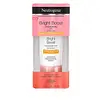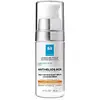What's inside
What's inside
 Key Ingredients
Key Ingredients

 Benefits
Benefits

 Concerns
Concerns

 Ingredients Side-by-side
Ingredients Side-by-side

Butyl Methoxydibenzoylmethane 1.5%
UV AbsorberHomosalate 5%
Skin ConditioningEthylhexyl Salicylate 4%
UV AbsorberOctocrylene 6%
UV AbsorberWater
Skin ConditioningGlycerin
HumectantCaprylyl Methicone
Skin ConditioningDiisopropyl Adipate
EmollientAcetyl Glucosamine
Skin ConditioningSilica
AbrasiveDimethicone
EmollientDicaprylyl Carbonate
EmollientSodium Acryloyldimethyltaurate/Vp Crosspolymer
Emulsion StabilisingPolyurethane-62
Caprylyl Glycol
EmollientPhenoxyethanol
PreservativeDimethicone Crosspolymer
Emulsion StabilisingParfum
MaskingGlyceryl Stearate
EmollientChlorphenesin
AntimicrobialTocopheryl Acetate
AntioxidantSodium Ascorbyl Phosphate
AntioxidantCitric Acid
BufferingDisodium EDTA
Trideceth-6
EmulsifyingMoringa Oleifera Seed Extract
Skin ConditioningMica
Cosmetic ColorantTitanium Dioxide
Cosmetic ColorantButyl Methoxydibenzoylmethane 1.5%, Homosalate 5%, Ethylhexyl Salicylate 4%, Octocrylene 6%, Water, Glycerin, Caprylyl Methicone, Diisopropyl Adipate, Acetyl Glucosamine, Silica, Dimethicone, Dicaprylyl Carbonate, Sodium Acryloyldimethyltaurate/Vp Crosspolymer, Polyurethane-62, Caprylyl Glycol, Phenoxyethanol, Dimethicone Crosspolymer, Parfum, Glyceryl Stearate, Chlorphenesin, Tocopheryl Acetate, Sodium Ascorbyl Phosphate, Citric Acid, Disodium EDTA, Trideceth-6, Moringa Oleifera Seed Extract, Mica, Titanium Dioxide
Butyl Methoxydibenzoylmethane 2.68%
UV AbsorberHomosalate 9.6%
Skin ConditioningEthylhexyl Salicylate 2.88%
UV AbsorberOctocrylene 5.38%
UV AbsorberBenzophenone-3 3.46%
UV AbsorberWater
Skin ConditioningDimethicone
EmollientCyclopentasiloxane
EmollientTocopherol
AntioxidantAcrylates/Dimethicone Copolymer
Skin ConditioningPhenoxyethanol
PreservativePropylene Glycol
HumectantCaprylyl Glycol
EmollientSilica
AbrasiveSodium Polyacrylate
AbsorbentAscorbyl Glucoside
AntioxidantScutellaria Baicalensis Root Extract
AstringentAcrylates/C10-30 Alkyl Acrylate Crosspolymer
Emulsion StabilisingDisodium EDTA
Diethylhexyl Syringylidenemalonate
Skin ProtectingPolyacrylamide
C13-14 Isoparaffin
EmollientLaureth-7
EmulsifyingCassia Alata Leaf Extract
AstringentMaltodextrin
AbsorbentTriethanolamine
BufferingButyl Methoxydibenzoylmethane 2.68%, Homosalate 9.6%, Ethylhexyl Salicylate 2.88%, Octocrylene 5.38%, Benzophenone-3 3.46%, Water, Dimethicone, Cyclopentasiloxane, Tocopherol, Acrylates/Dimethicone Copolymer, Phenoxyethanol, Propylene Glycol, Caprylyl Glycol, Silica, Sodium Polyacrylate, Ascorbyl Glucoside, Scutellaria Baicalensis Root Extract, Acrylates/C10-30 Alkyl Acrylate Crosspolymer, Disodium EDTA, Diethylhexyl Syringylidenemalonate, Polyacrylamide, C13-14 Isoparaffin, Laureth-7, Cassia Alata Leaf Extract, Maltodextrin, Triethanolamine
 Reviews
Reviews

Ingredients Explained
These ingredients are found in both products.
Ingredients higher up in an ingredient list are typically present in a larger amount.
Also known as Avobenzone, this ingredient is a chemical sunscreen filter that provides protection in the UV-A range.
Avobenzone is globally approved and is the most commonly used UV-A filter in the world.
Studies have found that avobenzone becomes ineffective when exposed to UV light (it is not photostable; meaning that it breaks down in sunlight). Because of this, formulations that include avobenzone will usually contain stabilizers such as octocrylene.
However, some modern formulations (looking at you, EU!) are able to stabilize avobenzone by coating the molecules.
Avobenzone does not protect against the UV-B range, so it's important to check that the sunscreen you're using contains other UV filters that do!
The highest concentration of avobenzone permitted is 3% in the US, and 5% in the EU.
Learn more about Butyl MethoxydibenzoylmethaneCaprylyl Glycol is a humectant and emollient, meaning it attracts and preserves moisture.
It is a common ingredient in many products, especially those designed to hydrate skin. The primary benefits are retaining moisture, skin softening, and promoting a healthy skin barrier.
Though Caprylyl Glycol is an alcohol derived from fatty acids, it is not the kind that can dry out skin.
This ingredient is also used as a preservative to extend the life of products. It has slight antimicrobial properties.
Learn more about Caprylyl GlycolDimethicone is a type of synthetic silicone created from natural materials such as quartz.
What it does:
Dimethicone comes in different viscosities:
Depending on the viscosity, dimethicone has different properties.
Ingredients lists don't always show which type is used, so we recommend reaching out to the brand if you have questions about the viscosity.
This ingredient is unlikely to cause irritation because it does not get absorbed into skin. However, people with silicone allergies should be careful about using this ingredient.
Note: Dimethicone may contribute to pilling. This is because it is not oil or water soluble, so pilling may occur when layered with products. When mixed with heavy oils in a formula, the outcome is also quite greasy.
Learn more about DimethiconeDisodium EDTA plays a role in making products more stable by aiding other preservatives.
It is a chelating agent, meaning it neutralizes metal ions that may be found in a product.
Disodium EDTA is a salt of edetic acid and is found to be safe in cosmetic ingredients.
Learn more about Disodium EDTAEthylhexyl Salicylate is an organic compound used to block UV rays. It primarily absorbs UVB rays but offers a small amount of UVA protection as well.
Commonly found in sunscreens, Ethylhexyl Salicylate is created from salicylic acid and 2-ethylhexanol. You might know salicylic acid as the effective acne fighter ingredient and BHA.
The ethylhexanol in this ingredient is a fatty alcohol and helps hydrate your skin, similar to oils. It is an emollient, which means it traps moisture into the skin.
According to manufacturers, Ethylhexyl Salicylate absorbs UV wavelength of 295-315 nm, with a peak absorption at 307-310 nm. UVA rays are linked to long term skin damage, such as hyperpigmentation. UVB rays emit more energy and are capable of damaging our DNA. UVB rays cause sunburn.
Learn more about Ethylhexyl SalicylateHomosalate is a chemical sunscreen filter that provides protection in the UV-B range (280nm - 320 nm), with a peak protection at 306 nm. It is internationally approved for use in sunscreens.
Homosalate is not photo-stable, meaning it's strength as a UV filter degrades over time with exposure to the sun. Because of this, it's often used in combination with other chemical sunscreen filters as avobenzone (which protects from the UV-A range). Homosalate also helps act as a solvent for harder-to-dissolve UV filters.
(Part of the reason that sunscreens need to be frequently re-applied is due to the photo instability of many chemical sunscreen filters)
Currently, homosalate is approved in concentrations up to 10% in the EU and 15% in the US. The FDA is currently doing further research on the effects of homosalate, and it is possible that these approved concentrations will change in the future.
Learn more about HomosalateOctocrylene protects skin from sun damage. It absorbs UV-B with peak absorption of 304 nm. It is a common sunscreen ingredient and often paired with avobenzone, a UVA filter. This is because octocrylene stabilizes other sunscreen ingredients by protecting them from degradation when exposed to sunlight. Octocrylene is a photostable ingredient and loses about 10% of SPF in 95 minutes.
Octocrylene also acts as an emollient, meaning it helps skin retain moisture and softens skin. It is oil-soluble and hydrophobic, enhancing water-resistant properties in a product.
Those who are using ketoprofen, a topical anti-inflammatory drug, may experience an allergic reaction when using octocrylene. It is best to speak with a healthcare professional about using sunscreens with octocrylene.
The EU allows a maximum of these concentrations:
Learn more about OctocrylenePhenoxyethanol is a preservative that has germicide, antimicrobial, and aromatic properties. Studies show that phenoxyethanol can prevent microbial growth. By itself, it has a scent that is similar to that of a rose.
It's often used in formulations along with Caprylyl Glycol to preserve the shelf life of products.
Silica, also known as silicon dioxide, is a naturally occurring mineral. It is used as a fine, spherical, and porous powder in cosmetics.
Though it has exfoliant properties, the function of silica varies depending on the product.
The unique structure of silica enhances the spreadability and adds smoothness, making it a great texture enhancer.
It is also used as an active carrier, emulsifier, and mattifier due to its ability to absorb excess oil.
In some products, tiny microneedles called spicules are made from silica or hydrolyzed sponge. When you rub them in, they lightly polish away dead skin layers and enhance the penetration of active ingredients.
Learn more about SilicaWater. It's the most common cosmetic ingredient of all. You'll usually see it at the top of ingredient lists, meaning that it makes up the largest part of the product.
So why is it so popular? Water most often acts as a solvent - this means that it helps dissolve other ingredients into the formulation.
You'll also recognize water as that liquid we all need to stay alive. If you see this, drink a glass of water. Stay hydrated!
Learn more about Water